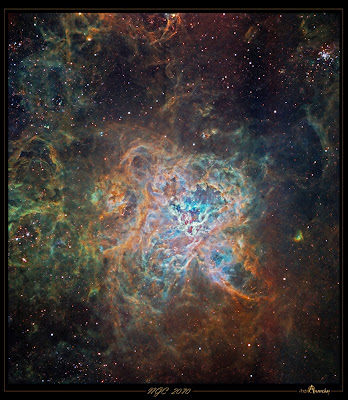COPYRIGHT, PLEASE NOTE
All the material on this website is copyrighted to J-P Metsavainio, if not otherwise stated. Any content on this website may not be reproduced without the author’s permission.
BUY A MUSEUM QUALITY POSTER
BUY A POSTER:https://astroanarchy.zenfolio.com/
Thursday, September 30, 2010
Stereo pairs of two nebulae, the "Tarantula" & the "Wizard"
The "tarantula Nebula"
Parallel vision
Cross vision
Other 3D-formats can be found here:
Original 2D-image and details:
The "Wizard Nebula"
Parallel vision
Cross vision
Other 3D-formats can be found here:
Original 2D-image and details:
NOTE! This 3D-study is a personal vision about forms and shapes, based on some known facts and an artistic impression.
Viewing instructions can be found from a Right hand side menu.
Viewing instructions can be found from a Right hand side menu.
Labels:
stereo images
Anaglyph 3D from two targets, the "Tarantula" & the "Wizard"
The "Tarantula Nebula"
You'll need Red/Cyan Eyeglasses to be able to see this image right.
Note, if you have a Red and Blue filters, you can use them! Red goes to Left eye
Other 3D-formats can be found here:
Original 2D-image and details:
The "Wizard Nebula"
Other 3D-formats can be found here:
Original 2D-image and details:
NOTE! This 3D-study is a personal vision about forms and shapes, based on some known facts and an artistic impression.
Labels:
anaglyph images and movies
Tuesday, September 28, 2010
A star suppression example
An animated image of the star and starless versions of the "Wizard Nebula"
I often use a starless image in one of the processing steps of the astronomical image.
Sometimes I publish the starless version too, it looks kind of nice, or spooky, that's a matter of taste.
If there is a dense star-field, nebula itself could be hard to detect. When stars are suppressed, the nebula can be seen better due the fact, that human brains tend to form false shapes from the cloud of dots.
Here is an example of my "Tone Mapping" technique:
A PDF-tutorial can be found behind this link:
Labels:
research and development
M57, the "Ring Nebula", a new imaging project
M57, NGC 6822, the "Ring Nebula", locates in constellation Lyra and the distance is about 2300 light years.
Last night I started a new imaging project with the M57. I'm targeting to expose outer shells of this planetary nebula. There is two layers of outer shells, both very dim. In this image the first shell is visible clearly and there is a hint of the second one. There is now 2h 40min. of H-alpha exposures, least ten more hours is needed to show the structure in H-a light.
The, 1.2 solar masses, white dwarf in the center of the nebula has visual magnitude 15,75. It can't be seen in a H-alpha light image, it will be interesting to see, if it'll shows at O-III channel I'm gonna shoot later.
Too bad, that I'm not able to shoot any broad band luminance data due my intense light pollution, with H-a, needed exposure time will be very long..
Too bad, that I'm not able to shoot any broad band luminance data due my intense light pollution, with H-a, needed exposure time will be very long..
This target is not very high, here at 65N. Maximum elevation is about 50 degrees and after two and half hours, it was only about 30. Since this is a small target, good seeing and reasonable altitude is needed to show any details.
Technical details:
processing work flow:
Image acquisition, MaxiDL v5.07.
Stacked and calibrated in CCDStack.
Levels and curves in PS CS3.
Telescope, Meade LX200 GPS 12" @ f5
Camera, QHY9 Guiding, SXV-AO @ 10Hz
Image Scale, 0,75 arcseconds/pixel
Exposures H-alpha 7x1200s, binned 1x1
Subscribe to:
Posts (Atom)

















